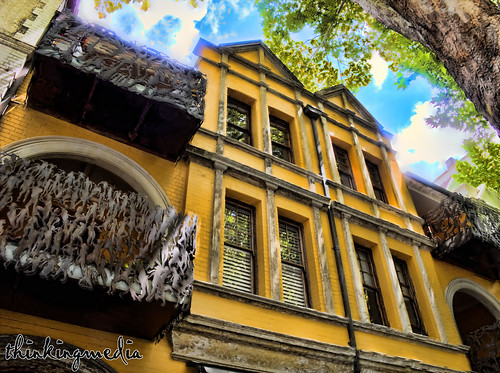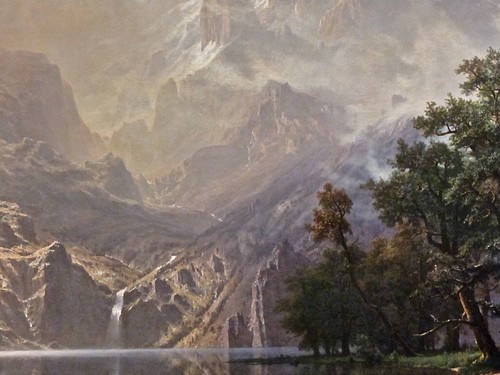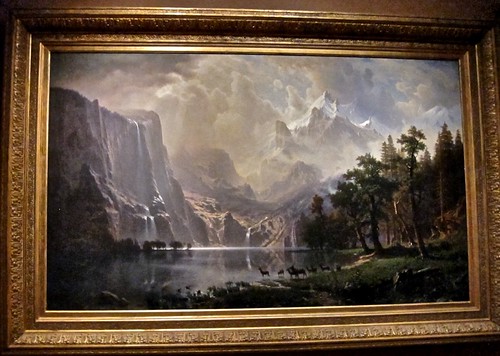The Yellow House c.1970
Image by Sydney Heritage
See where this picture was taken. [?]
The house at 59 Macleay St is a "Queen Anne" terrace, one of ten designed and built in the late 1890's by architect Maurice Halligan. Its design was in many ways a wide departure from the ordinary style of terrace adopted across Sydney in that era, differentiated by distinctive gables and balconies set back behind roman arches.
During the 1950s, No. 59 Macleay Street was a haven for many of Australia's best-known artists. It was the scene for the emergence and acceptance of an important phase of contemporary art within Sydney. The property’s resident owner, writer Frank Clune, author of dozens of popular books on history and travel, started this artistic link. In 1959 the Terry Clune Galleries opened on the premises, exhibiting Sydney's emerging abstract and modernist artists -- John Olsen, Robert Hughes (now New York based art critic for 'Time' magazine), the late Robert Klippel, Stan Rapotec and others. During this period the Clune family house was also home to a number of artists, including Russell Drysdale who lived there for a short time.
The building's most colourful and famous period began in late 1969. Martin Sharp was frustrated by the traditional gallery scene, so he approached the owners to make use of the disused Clune Galleries space. Sharp had returned to Australia in early 1969 after spending several years in London. During his period in the UK he created posters and illustrations for the infamous Oz magazine (working with his friend Richard Neville) as well as designing the famous covers for Cream's albums Disraeli Gears and Wheels Of Fire. Sharp took up residency in the old Clune Galleries. Thelma Clune, the gallery director, had decided to sell the building,but was in no hurry to do so, so Martin was able to use the space to present his first exhibition after his return home. This was followed by ''The Incredible Shrinking Exhibition", which comprised photographs of the first show re-exhibited in small gem-like mirror frames.
These two exhibitions laid the foundations for The Yellow House. The project was inspired by an unrealised dream of Vincent Van Gogh, who had mentioned the idea in a letter to his brother Theo. Van Gogh envisaged setting up his house in Arles as a centre for artists to live, work and exhibit. During the late 1960s Conceptual Art had emerged as a major new movement, and novel combinations of music, theatre, film, slides, lightshows and live performances of music and/or dance -- "total environment installations" or "happenings" -- had . Public awareness of conceptual art in Australia was given a major boost by the French artist Christo, who came to Australia in late 1969 and created his famous "Wrapped Coast" at Little Bay.
Sharp produced a catalogue and coordinated the setting up of artists' spaces to be prepared for the Spring show of 1970. In many repsects, the creation of The Yellow House was the culmination of much of the activity on the Sydney "Underground" scene of the late '60s. Sharp's contact with the UBU film/lightshow collective led to several UBU members -- Albie Thoms, Aggy Read, Phil Noyce -- becoming closely involved in the Yellow House. The opening attracted considerable media attention. Sydney's Sunday Mirror called it .."the wildest, most way out happening of the week..", and commented that "...the guests wore really wild gear, and many looked as though they had come from a performance of Hair ... " -- which had opened a few weeks earlier at the nearby Metro Theatre in Kings Cross.
The Yellow House was an innovative 'multimedia' space, perhaps the first permanent "happening" in Australia. It included artworks by Sharp, Brett Whiteley and others, a special sound system created by Aggy Read, films by Read and Philip Noyce, "Lumino Kinetic" lighting presentations by Ellis D. Fogg, tapdancing by Little Nell (aka Laura Campbell, who later played Columbia in The Rocky Horror Picture Show) and photography by Greg Weight. Other well-known names associated with the Yellow House included painters Tim Lewis, George Gittoes and Bruce Goold (now one of the group of artists who contribute designs to the famous Mambo clothing company), and film-makers Albie Thoms, Peter Weir and Jim Sharman.
The rooms were transformed into a range of environments, many reflecting the influence of the Surrealists. One was an homage to Magritte, another a bonsai room created by Brett Whiteley. The Stone Room contained everyday objects made to look like stone. The exterior was painted yellow and the building became known as "The Yellow House" as a tribute to Van Gogh. The House took on roles which extended beyond a simple exhibition space and it increasingly became known for its music and performances by people such as Little Nell, Bruce Goold and George Gittoes; films were screened and classes in film-making and folk music were organised by Albie Thoms. As well as exhibiting there, Greg Weight photographed the interiors of the House extensively, documenting this exciting moment in Australia’s art history. Weight’s photographs record the wondrous environments of the Yellow House, such as The Stone Room, but are also artworks in themselves, tributes to what Sharp claimed to be "probably one of the greatest pieces of conceptual art ever achieved".
The Yellow House continued in operation for most of 1971, but during the latter part of the year financial problems and artistic tensions led to the departure of Sharp, Gittoes and Thoms. The House continued as a performance space for some time after, presenting acts like The Captain Matchbox Whoopee Band and Lindsay Bourke, but without a clear artistic direction it became little different from other performance venues and it closed towards the end of the year.
The Yellow House was a milestone in the history of contemporary art in Australia and its importance was recognised by a retrospective exhibition at the Art Gallery of New South Wales in 1990, coinciding with the centenary of Van Gogh’s death in Auvers, France on the 29th July 1890.
Jumbotron collage
Image by Trisha Weir
There is, perhaps, dubious artistic merit in taking pictures of someone else's live video feed fed through someone else's on-the-fly effects filters. But the choice of frame is mine, and I liked the facial expressions here.
Detail of Among the Sierra Nevada
Image by ellenm1
by Albert Bierstadt
Bierstadt's beautifully crafted paintings played to a market eager, in the 1860s for spectacular views of the nation's frontiers. Bierstadt was an immigrant and a hardworking entrepreneur who had grown rich pairing his artistic skill with a talent for self-promotion. The unveiling of one of his canvases was a theatrical event. He sold tickets and planted news stories, strategies that one critic described as the "vast machinery of advertisement and puffery." A "great picture" was elaborately framed and installed in a room with carefully controlled lighting. At the appointed time, the work was revealed to thunderous applause.
Bierstadt painted "Among the Sierra Nevada, California" in his Rome studio, then showed the canvas in Berlin and London before shipping it to the United States. Works such as this fueled the image of America as a promised land just when Europeans were immigrating to this country in great numbers. When the painting was shown in Boston, one critic recognized that the landscape was a fiction invented from Bierstadt's sketches of the West. Nevertheless the writer felt that it represented "what our scenery ought to be, if it is not so in reality."
Among the Sierra Nevada, California
Image by ellenm1
by Albert Bierstadt
Bierstadt's beautifully crafted paintings played to a market eager, in the 1860s for spectacular views of the nation's frontiers. Bierstadt was an immigrant and a hardworking entrepreneur who had grown rich pairing his artistic skill with a talent for self-promotion. The unveiling of one of his canvases was a theatrical event. He sold tickets and planted news stories, strategies that one critic described as the "vast machinery of advertisement and puffery." A "great picture" was elaborately framed and installed in a room with carefully controlled lighting. At the appointed time, the work was revealed to thunderous applause.
Bierstadt painted "Among the Sierra Nevada, California" in his Rome studio, then showed the canvas in Berlin and London before shipping it to the United States. Works such as this fueled the image of America as a promised land just when Europeans were immigrating to this country in great numbers. When the painting was shown in Boston, one critic recognized that the landscape was a fiction invented from Bierstadt's sketches of the West. Nevertheless the writer felt that it represented "what our scenery ought to be, if it is not so in reality."
Detail of Among the Sierra Nevada
Image by ellenm1
by Albert Bierstadt
Bierstadt's beautifully crafted paintings played to a market eager, in the 1860s for spectacular views of the nation's frontiers. Bierstadt was an immigrant and a hardworking entrepreneur who had grown rich pairing his artistic skill with a talent for self-promotion. The unveiling of one of his canvases was a theatrical event. He sold tickets and planted news stories, strategies that one critic described as the "vast machinery of advertisement and puffery." A "great picture" was elaborately framed and installed in a room with carefully controlled lighting. At the appointed time, the work was revealed to thunderous applause.
Bierstadt painted "Among the Sierra Nevada, California" in his Rome studio, then showed the canvas in Berlin and London before shipping it to the United States. Works such as this fueled the image of America as a promised land just when Europeans were immigrating to this country in great numbers. When the painting was shown in Boston, one critic recognized that the landscape was a fiction invented from Bierstadt's sketches of the West. Nevertheless the writer felt that it represented "what our scenery ought to be, if it is not so in reality."
No comments:
Post a Comment